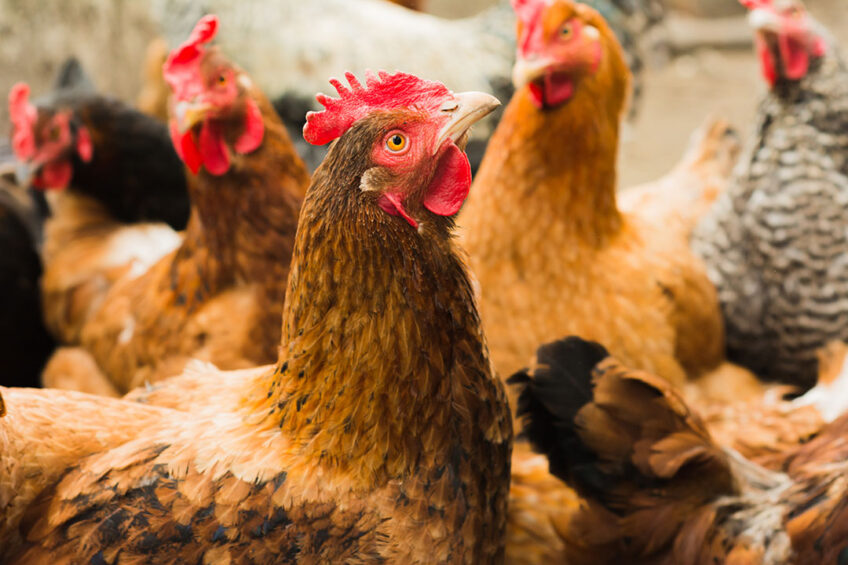Beneficial dietary fibre in laying hens

The digestive tract of poultry is not comparable with ruminants, so what would be the sense of feeding dietary fibre? The answer is that poultry also depend on having a balanced microbiota in the hindgut.
To maintain eubiosis in the large intestine, it is necessary to provide fermentable dietary fibre as a nutritional basis and energy source for the gut bacteria.
Until a few years ago, the issue of dietary fibre attracted little, if any, interest in the field of poultry nutrition. On top of which it had a poor reputation. Why? Because the physiological benefits were ignored and there always was – and even today, still is – the question of energy dilution. It is true that most fibre sources take up too much ‘space’ in high-energy poultry diets. Beyond that, varying fibre content and possible contamination with mycotoxins are further limiting factors.
Inflammation and immune activity cost energy
The gut is a highly complex ecosystem in which commensals and pathogens live in dynamic antagonistic interactions competing for the same niches and substrates. Any alterations in these relationships may lead to inflammatory reactions, gastrointestinal or systemic infections – in any event, to energy-consuming imbalances. Read more…
Quality and quantity of dietary fibre
Diets for farm animals typically focus on energy level and digestibility but neglect the quality and quantity of dietary fibre. During phases of inadequate fibre supply, many species of gut bacteria use the glycoproteins of the mucus layer as an energy source instead of fibre. This inadequate supply results in an imbalance in the gut flora, degradation of the mucus layer and leads to issues like wet litter, dirty eggs, feather pecking and cannibalism. These problems all affect health and performance.
Substrate for microbiota
Dietary fibre is made up of complex carbohydrates that are not digested by the endogenous enzymes of the animal but broken down by specialist enzymes produced by the gut bacteria. Dietary fibre is an important factor in shaping the gut microbiota as it forms the substrate for these micro-organisms.
Dietary fibre is broken down by bacterial enzymes, the metabolites are used by the micro-organisms but they are also very important to the host animal. The presence of dietary fibre specifically promotes those bacteria in the intestinal flora that can break down fibre. Thus favouring microbial diversity in the intestine. A lack of dietary fibre decreases microbial diversity and reduces the thickness of the mucus layer.

The main fermentation products in the breakdown of dietary fibre are short-chain fatty acids (SCFAs; acetate, propionate, butyrate) and lactate. Acetate acts as an energy source for the host animal. From propionate, the host animal can synthesise glycogen in the liver.
A healthy, diverse intestinal flora is an important factor in the condition and performance of the animal.
Butyrate is the most important energy source for the epithelial cells of the intestine and contributes to the proliferation and health of the gut mucosa. Lactate and lactate-producing bacteria are beneficial to intestinal health, regulating the growth of undesirable, potentially pathogenic bacteria. Overall, a healthy, diverse intestinal flora is an important factor in the condition and performance of the animal and has a prophylactic effect in preventing digestive disorders, wet litter and dirty eggs. The various metabolites (lactate and SCFAs) are also in a steady state with each other. The bacteria Faecalibacterium and Roseburia, for example, use acetate to produce butyrate.
Lignocellulose a highly concentrated fibre
Lignocellulose is a natural fibre concentrate made of fresh wood. Within the group of lignocellulose products there are also variations that are worth considering, e.g., for fermentability. The original lignocellulose consists of completely insoluble and non-fermentable fibre. While scientifically enhanced lignocellulose (OptiCell) is also insoluble, it contains fermentable fibre. Because it was developed to support the health and diversity of the intestinal flora, it is also called eubiotic lignocellulose.
Compared with other fibre sources lignocellulose has an outstanding benefit: it is highly concentrated. Eubiotic lignocellulose reaches its full potential at low inclusion rates of 0.5-1.0% and therefore, can be easily included in high-energy diets. The fibre content varies only within a very small range, it is free of mycotoxins and pathogenic bacteria, making it safe and easy to handle as a fibre source. Scientific study has shown that the energy dilution is negligible and more than offset by the physiological benefits.
Modulating intestinal flora
This experiment was conducted with 72 ISA Brown laying hens, starting with day-old chicks, up to the age of 8 weeks. A total of 2 groups were compared: a control group and a trial group that received 1% eubiotic lignocellulose. Body weight and feed intake were recorded in both groups. In each group, 6 chickens were housed separately to collect faeces. The same 6 animals were euthanised at the end of the trial period to collect samples of the caeca. The parameters influenced by lignocellulose supplementation are shown in Table 1. The performance parameters were slightly better in the trial group but this effect could not be statistically validated.
The positive performance data in this field trial (Table 2) can be attributed to the presence of SCFAs. The use of SCFAs resulted in better and a more even energy utilisation of the feed. Thus, more energy was available to the hens for egg production. This is also reflected in the better feed conversion. The animal’s metabolism becomes more efficient which is beneficial for its performance and health.
Improved gut metabolism
The study showed that the addition of eubiotic lignocellulose has a positive influence on various parameters for intestinal health and metabolism in the caecum of young laying hens. Eubiotic lignocellulose influences egg production and feed conversion in the laying phase. The connection is clear given that SCFAs contribute to a more consistent energy supply and thus have a positive effect on the health and performance of the animals.
Author:
Nina Neufeld, Neufeld GmbH












